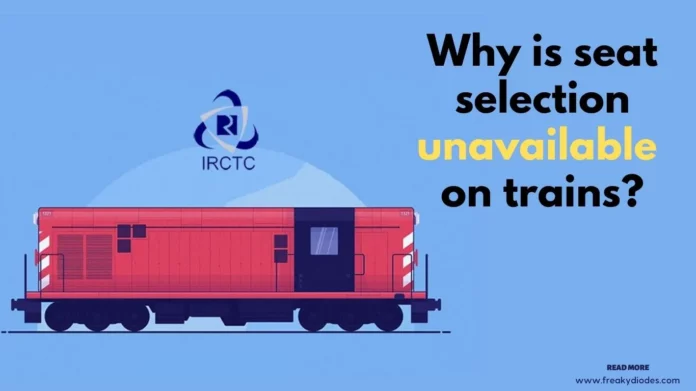Let’s delve into the fascinating world of science to uncover the secrets behind this puzzling scenario. Imagine this: you’ve successfully logged into the IRCTC website, your heart set on securing that perfect window seat for your upcoming journey. You spot a whopping 500 available tickets and feel a surge of hope and excitement.
However, when you finally hit that book button, things take an unexpected turn. You don’t get the window seat you had your eyes on, and yet you notice that there are still 499 tickets left. What’s going on here? Well, dear reader, it’s time to embark on a journey of discovery as we unravel the science behind this intriguing concept!
The Science Behind the Concept of IRCTC

Let’s take a closer look at the intricate algorithm that IRCTC employs to allocate seats in a way that ensures the safety and balance of the moving trains.
raw comparison to shed light on why train bookings differ from the familiar experience of selecting seats at a theater. In a theater, we’re accustomed to choosing our seats for an enjoyable movie night. It’s a straightforward process because the theater remains stationary throughout the show. You pick your spot, settle in, and enjoy the film.
Now, when it comes to train bookings, it’s a whole different ballgame, and the key player here is physics. Unlike a theater, a train is a moving entity. And because of this crucial factor—motion—the way seats are assigned takes on a different approach.
Why is it done by IRCTC?
It all boils down to ensuring passenger safety. Imagine if everyone on a moving train could freely choose their seats without any rules. The train’s weight distribution could become uneven, potentially leading to instability, derailment, or other safety hazards.
So, in the world of train travel, the distribution of loads must be carefully managed to maintain that crucial balance. While it might not be as flexible as choosing your theatre seat, it’s all in the name of keeping train journeys safe and sound.

Another Factor of IRCTC
According to a railway board member, “booking of seats is done according to the profile of the passenger. Lower berth seats on trains are designated for passengers over 45, senior citizens, and pregnant women. This allocation prioritizes comfort and accessibility for these specific passenger groups, ensuring a more convenient and safe travel experience for them during their journey”.
What if tickets were booked randomly?
Certainly, let’s dive into the dynamics of a moving train. Picture this: a train zipping along at a minimum speed of 100 km/h. Now imagine that the first three coaches are packed to the brim with passengers, while the last three have plenty of empty seats, leaving the middle three carriages eerily quiet.
When this train decides to make a turn, something interesting happens. Some compartments get thrown into a whirlwind of centrifugal force, while others barely feel a breeze of it. This imbalance is like a seesaw of forces within the train itself. And here’s the catch: it can significantly increase the risk of derailment.
But wait, there’s more. Braking forces come into play, and they don’t play favorites. They act differently because of these substantial variations in coach weight. It’s like trying to stop a car with unevenly distributed weight; it doesn’t handle as smoothly.
So, you see, when we’re dealing with a speeding train, it’s all about keeping that delicate balance to ensure everyone’s safety on board. Any sudden jerks or imbalances could lead to a rather undesirable outcome – and that’s exactly why uniform seat allocation is crucial in the world of rail travel.
Addressing Flaws
The railway ticket booking system adheres to a specific allocation method to uphold train stability and safety. To elucidate this, one may inquire about the ratio of the collective weight of 72 passengers occupying a coach to the inherent weight of the coach itself. This proportion signifies the weight distribution within the train. It is pivotal for maintaining equilibrium during travel, averting excessive centrifugal forces during turns, and ensuring the effectiveness of braking systems. Such calculations underline the meticulous engineering considerations that underpin railway operations, emphasizing the significance of uniform seating distribution as a safeguarding measure in the realm of rail transportation.
The chances of a train derailment can increase due to the maximum centrifugal force. Hence, the Indian Railways keeps this responsibility reserved. It ensures that the passengers are evenly distributed.
- Accenture Off Campus Drive 2024 | Hiring for Application Developer | Opportunity for 2024/2023/2022 Graduates
- Wipro Off Campus Drive 2024 | Opportunity for Graduates
- Yash Technologies Off Campus Drive 2024 | Opportunity for 2024 & 2023 Graduates
- Oracle Off-Campus Drive 2024 | Hiring for Software Engineer | Opportunity for 2024, 2023 & 2022 Graduates
- Hitachi Off Campus Drive 2024 | Freshers Hiring | Opportunity as Associate Analyst
Stay ahead in the game and never miss out on exciting opportunities! Follow our social media handles for the latest updates on jobs, internships, and projects. Join our vibrant community of tech enthusiasts to unlock your potential and discover a world of endless possibilities. Let’s embark on this journey together!
| Join Our Telegram Channel | Click Here |
| Join Our WhatsApp Group | Click Here |
| Follow us on LinkedIn | Click Here |
| Follow us on Facebook | Click Here |
| Follow us on Instagram | Click Here |








